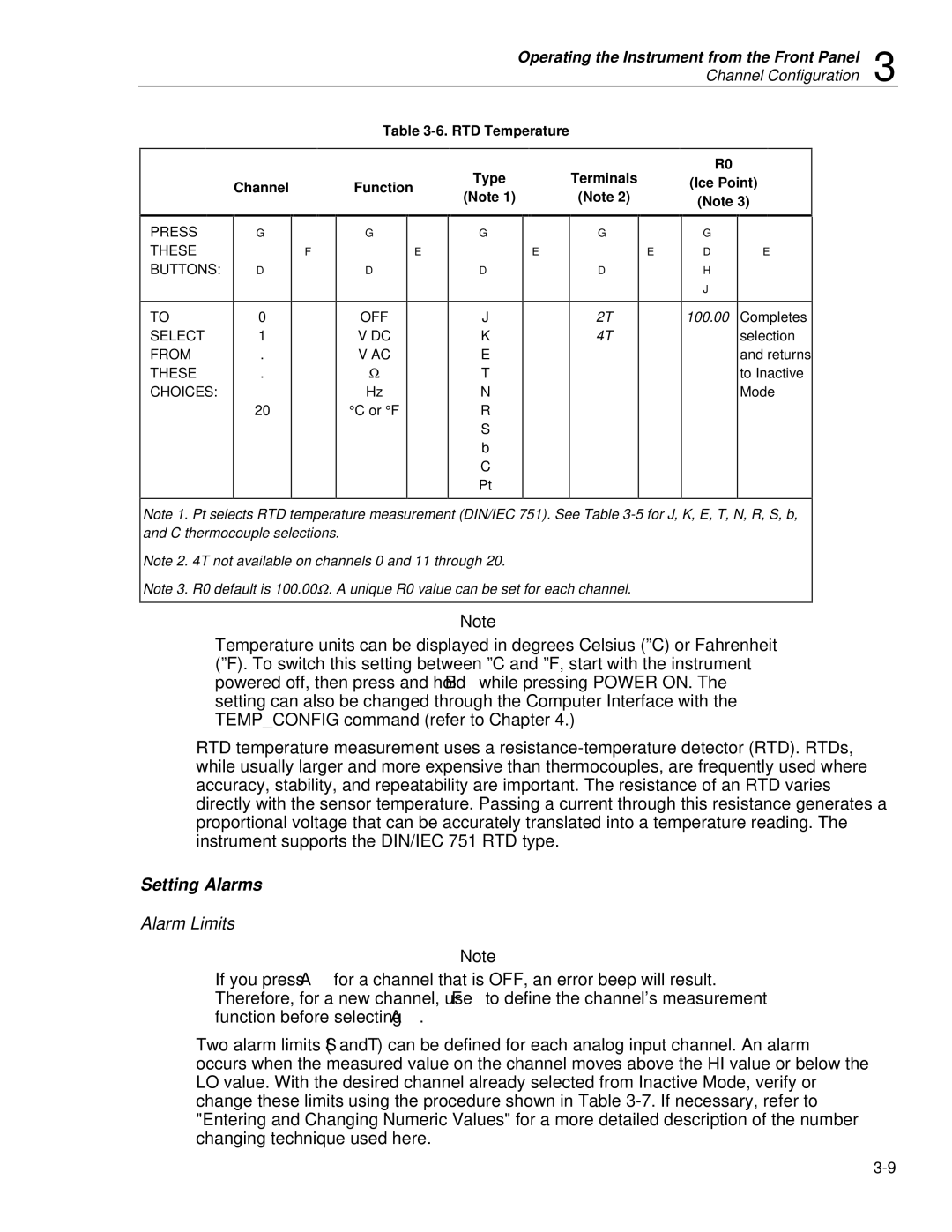2620A/2625A
Limited Warranty & Limitation of Liability
Table of Contents
Operating the Instrument from the Front Panel
2620A/2625A
Additional Considerations
Index
List of Tables
Performance Tests Voltage, Resistance, and Frequency
List of Figures
Interference Information
Symbols Marked on Equipment
Safety Terms in this Manual
Use the Proper Fuse
2620A/2625A AC Power Source
DC Power Source
Use the Proper Power Cord
Basics
Setting Up a Channel
Getting Started
Introduction
Selecting the Scan Data Destination
Taking Measurements
Viewing Minimum, Maximum, and Last Data Values
Last MIN MAX
Xvi
Introduction
2620A, 2625A
Options and Accessories
Hydra Series II Data Acquisition Unit
Hydra Series II Data Logger
Hydra Features
Model
Where to go From Here
Accessories
Accessories Description
Introduction
Using the Computer Interface
Maintenance
Getting Started
Overview
2620A, 2625A
Unpacking and Inspecting the Instrument
Setting Up the Instrument
Adjusting the Handle
Introduction
Front/Rear Panel Features
Line Power
Channel Configuration Buttons
Active Mode Buttons
Power Button PRINT/COMMUNICATIONS Buttons
Instrument Configuration Buttons
REM Scan SET
Auto MON
Func Alarm OFF Auto Limit
MON Scan SET
Display Annunciators
EXT REM CAL
HI, LO Review MIN, MAX Last PRN
Operating Modes
Turning the Instrument On
Input Channels
Right Display
Front Panel Display
Reading the Display
Left Display
Front Panel Pushbuttons
Using the Buttons
Front Panel Buttons
Selecting a Channel
Setting up a Channel
Setting up a Channel
Alarm Limits
Setting Alarm Limits and Mx+B Scaling Values
Mx+B Scaling
Setting the Scan Interval
Using the Monitor Function
Using the Scan Function
Reviewing Channel Data
Review Array Review Points
Using External DC Power
Viewing the Totalizer Count
Activate
Using the Rack Mount Kit
Entering and Changing Numeric Values
Operating the Instrument from the Front Panel
2620A, 2625A
Configuration Mode
What is the Present Configuration?
Channel Configuration
Other Displayed Data
Configuration Reset Settings
Power on
Digital I/O Line Assigned to Channels
From
DC Voltage, AC Voltage Function Range
Press These Buttons OFF
Select
Frequency
Resistance
Press Buttons OFF Select
Setting Alarms
Alarm Limits
RTD Temperature Type Terminals
Alarm Selection ChannelAlarm
Alarm Indications
Using the Digital I/O Lines
Resetting Alarm Conditions
To define the scaling values
Initial Alarm Assignments, Digital I/O Lines 4 Through
Page
Sign, M Decimal Multiplier Value Point Position
Instrument Configuration
Entering and Changing Numeric Values
Press These Buttons To Select
10. Scan Interval Minute
Selecting Scan Interval
Selecting the Measurement Rate
Hour
11. Measurement Rate Selection
Changing the Temperature Unit
Triggering
External Triggering
Mn.dY Hr.nn
Setting Date and Time of Day
Measurement Connections
Date/Time Selection Year Month.Day Hour.Minut
DC Volts, AC Volts, Frequency, and Thermocouples
Input Module Connections
Strain Relief
Negative Lead Material
Resistance and RTD
14. Thermocouple Ranges Positive Lead Type Material
Positive Lead Color
11 12 13 14 15 16 17 18 19 3 4 5 6 7 8 9
11 12 13 14 15 16 17 18 19
Connections
Totalizing
Review Array
General
Activate Note 15. Review Array Review Points
List Button Functions
16. List Button Operation
Memory Storage
Autoprint
Front Panel Lock out Conditions
Front Panel Review Only Function
Front Panel Monitor Only Function
REM Annunciator
Calibration
Computer Interface-Initiated Lockouts
2620A, 2625A
Using the Computer Interface
Computer Interface Command Set
Using the RS-232 Computer Interface
Front Panel and Computer Interface Operations
Types of Computer Interface
Setting Communication Parameters RS-232
Parity = E or Odd
Parity = No
Autoprint and Memory Storage RS-232
Autoprint Computer Interface Control
Autoprint Output Format
Memory Retrieval
Memory Storage Computer Interface Control
Memory Full Operation
Clearing Memory
Cabling the Instrument to a Host or Printer RS-232
Character Echoing
Installation Test
Device Clear Using Ctrl C
RS-232 Information
RS-232 Prompts
Using the IEEE-488 Interface
Sample Program Using the RS-232 Computer Interface
Installing the IEEE-488 Interface
Sample Program
Gosub
IEEE-488.1 Capabilities Description
IEEE-488 Setup BaudAddress
Enabling the IEEE-488 Interface
Capability
How the Instrument Processes Input
General Information RS-232 and IEEE-488
Input Strings
Input Terminators
Typical Input Strings
Func 1, OHMS, 3
Func 1, TEMP, PT, 2 RTDR0 12
Intvl 0, 10, 0 Scan 1 LAST?
How the Instrument Processes Output
Sending Input Strings to the Instrument
Service Requests IEEE-488 only and Status Registers
ESB
Status Byte Register Description
Event Status and Event Status Enable Registers
Status Byte Register
Bit Name
Event Status Register Description
Reading the Status Byte Register
Instrument Event Register
Service Request Enable Register
Instrument Event Register IER
Computer Interface Command Set
Command and Query Summary
RATE?
Lock
LOCK?
Rate
Intvl INTVL? Scan SCAN? SCANTIME?
Tempconfig TEMPCONFIG?
Format FORMAT?
Reviewclr
Command and Query Reference
ESE? ESR? IDN? OPC OPC? RST
Field Description
SRE? STB? TRG TST?
Computer Interface Command Set
ALARMS?
Limit ALARMASSOC? channel,limitnum Channel
Date
LO OFF
Dolevel Echo Format
Ohms
FORMAT? Func Measurement Units String
VDC
VAC
TEMP, VAC, VDC, OHMS, FREQ, OFF
FUNC? IEE
IEE? IER? Intvl INTVL? LAST?
Lock LOCK? Locs LOG?
LOGGED? LOGBIN? Logclr LOGCOUNT?
Logmode LOGMODE? Lwls MAX?
MON MONCHAN? MONVAL?
Store Scans
Print PRINT? Printtype
Rate RATE?
RTDR0 RTDR0?
Code Display MAX Offset Value
Scan SCAN? SCANTIME? Tempconfig
TEMPCONFIG? Time TIMEDATE?
Total TOTAL? Totaldbnc TOTALDBNC? Trigger
Returns an integer representing the present trigger type
Additional Considerations
2620A, 2625A
Computer Interface Trigger Control
Measurement Rate
Advanced Trigger Mechanisms
Front Panel Trigger Control
External Trigger Enabled Type
Both External and Monitor Alarms Disabled Type
LOW Ignored Scan Falling Progress Edge
High Valid External Triggers Scan Time
When Measuring Resistance or Temperature RTD
Monitor Alarm Enabled Type
Thermal Voltages
When Measuring Resistance or Temperature Rtd
Ohms Test Voltage Range
True RMS Measurements
Effects of Internal Noise in AC Measurements
Waveform Comparison True RMS vs Average Responding
Making Mixed Measurements
Comparison of Common Waveforms
General Rule
Using Shielded Wiring
Non-Isolated Sensor Configuration
Isolated and Shielded Sensor Configuration
More Detail
Thermocouple Measurement Range Accuracy Test
Maintenance
2620A, 2625A
Introduction Cleaning
Self-Test Diagnostics and Error Codes
Line Fuse
Replacing the Line Fuse
Performance Tests
Performance Tests
Error Power-Up Error Codes Description
Instrument Type Recommended Model
Recommended Test Equipment Minimum Specification
Instrument Type
Recommended Model
Channel Integrity Test
Accuracy Verification Test
MIN MAX
Performance Tests Voltage, Resistance, and Frequency
Thermocouple Measurement Range Accuracy Test
Terminal Resistance Test
Func 0,VDC,I100MV CR MON 1,0 CR MONVAL? CR
Thermocouple Temperature Accuracy Test
Sense Source
Wire
5700A
OFF Comp
Decade Resistance BOX Hydra Input Module
Open Thermocouple Response Test
Year @ 18-28C
RTD Temperature Accuracy Test
RTD Temperature Accuracy Test Using DIN/IEC
Digital Input/Output Verification Tests
Year @ 18-28 Degrees C
Digital Input Test
Digital Output Test
Digital Input Values
Totalizer Test
Totalizer Sensitivity Test
Dolevel 0,0 CR Dolevel 0,1 CR
Dedicated Alarm Output Test
2 3 4 5 6 7 Σ + 0 1 2 3 TR
Dedicated Alarms Output Test
2 3 4 5 6 7 Σ
External Trigger Input Test
Variations in the Display
Service
Appendix Title
Appendices
Page
Specifications
Accuracies at Ambient Temperatures Other Than Specified
Response Times
DC Voltage Inputs
Year Slow Year Fast
Thermocouple Inputs
2620A/2625A
Type
Common Mode and Normal Mode Rejection
RTD Inputs
Open Thermocouple Detect
IEC 751, Amendment 2, 100 e Platinum ITS-90
Wire Accuracy
Range Resolution Slow Fast
AC Voltage Inputs
Slow Fast
Range Frequency Year Accuracy ±% ± 18C to 28C 0C to 60C
Maximum AC Input
Crest Factor Error
DC Component Error
Maximum Crest Factor
Ohms Inputs
Input Protection
Maximum Current Through Unknown
Sensitivity
Range Resolution Accuracy + % ± Hz Slow Fast
Frequency Inputs
Frequency Range
Auto
VDC Temperature VAC Ohms Frequency
Typical Scanning Rate
Auto PT RTD
Maximum Autoranging Time
Totalizing Input
Digital Inputs
Maximum Latency
Trigger Input
Input Voltages
Minimum Pulse Width Maximum Frequency Specified Conditions
Digital and Alarm Outputs
Real-Time Clock and Calendar
Environmental
General
2620A Options
2625A Data Storage
Ascii & IEEE-488 Bus Codes
KEY
Implementation of Ieee Standard
IEEE-488.2 Devise Documentation Requirements
Program Message Program Message Terminator
ALARMLIMIT?
*RDT and *RDT? commands are not implemented
Operation complete is generated when the command is parsed
2620A/2625A
Making Mixed Measurements
Signal Cross Talk in a DC Voltage Channel
AC Signal Cross Talk Into an AC Voltage Channel
AC Signal Cross Talk Into an Ohms Channel
AC Signal Cross Talk Into a Frequency Channel
AC Signal Crosstalk Into a Temperature Channel
2620A/2625A
Decoding the Ascii String
Binary Upload of Logged Data LOGBIN? 2625A only
Figure E-1. Ascii String Decoding
Floating Point Conversion
Example
Figure E-2. Floating Point Conversion
Figure E-3. Example
RS-232 Cabling
Connections
Cables
Figure F-1. Summary of RS-232 Connections
Figure F-2. Hydra DB-9 to PC DB-9 RS-232 Connection Generic
Figure F-3. Hydra DB-9 to PC DB-25 RS-232 Connection
Figure F-4. Hydra DB-9 to Modem DB-25 RS-232 Connection
Figure F-5. Hydra DB-9 to Printer DB-25 RS-232 Connection
Connector
Side Male Female
Side
2620A/2625A
Output
Temperature Units
Scan Rate
Communication I/F
Index
2620A/2625A

